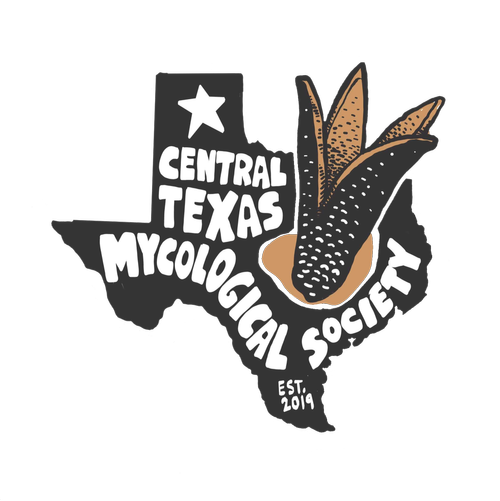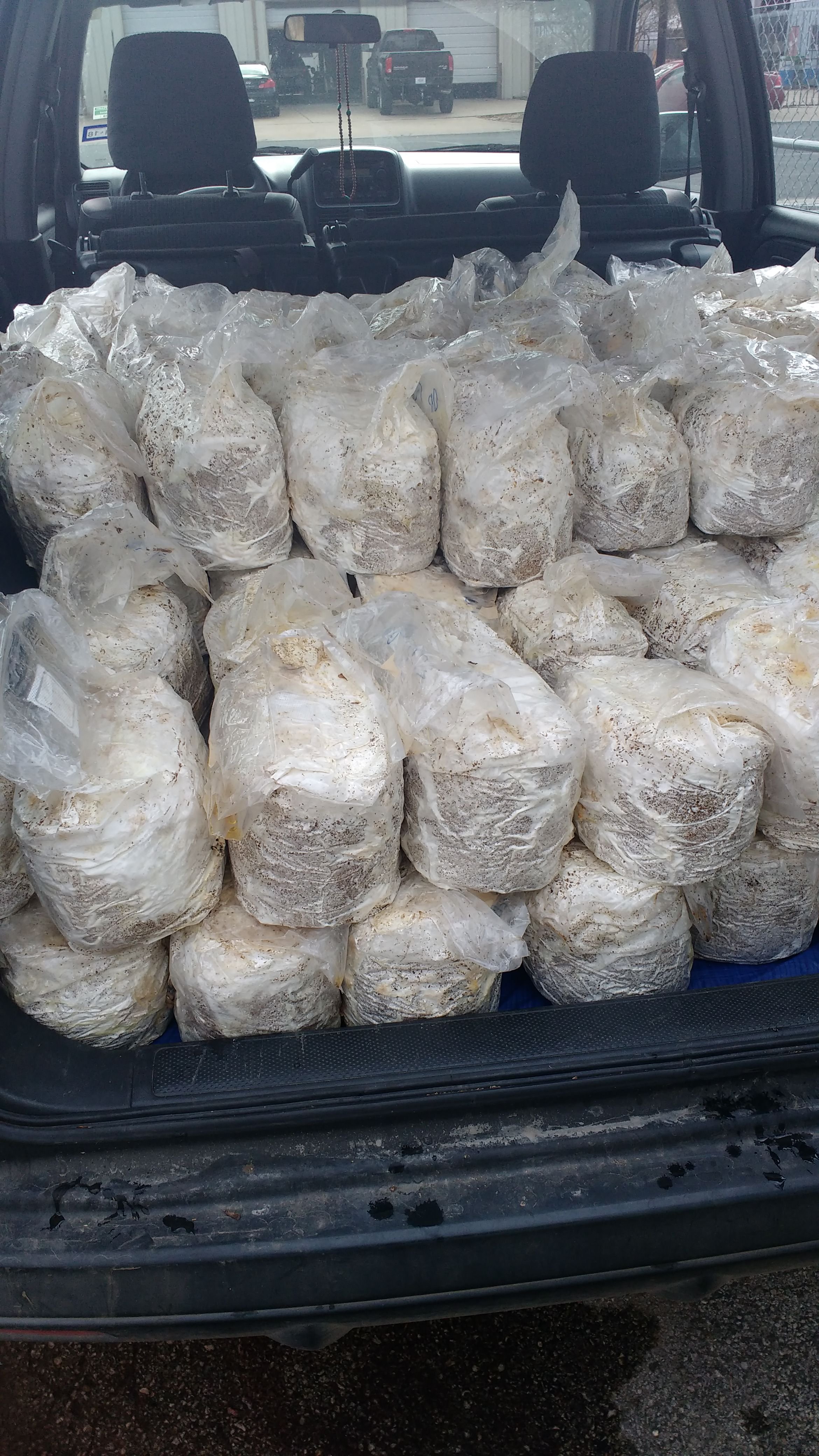October Foraging Forecast
Learn wild, edible mushrooms fruiting in Texas after rain.
Learn wild, edible mushrooms fruiting in Texas after rain.
Comes with download of a Wild Edible Mushroom Calendar.
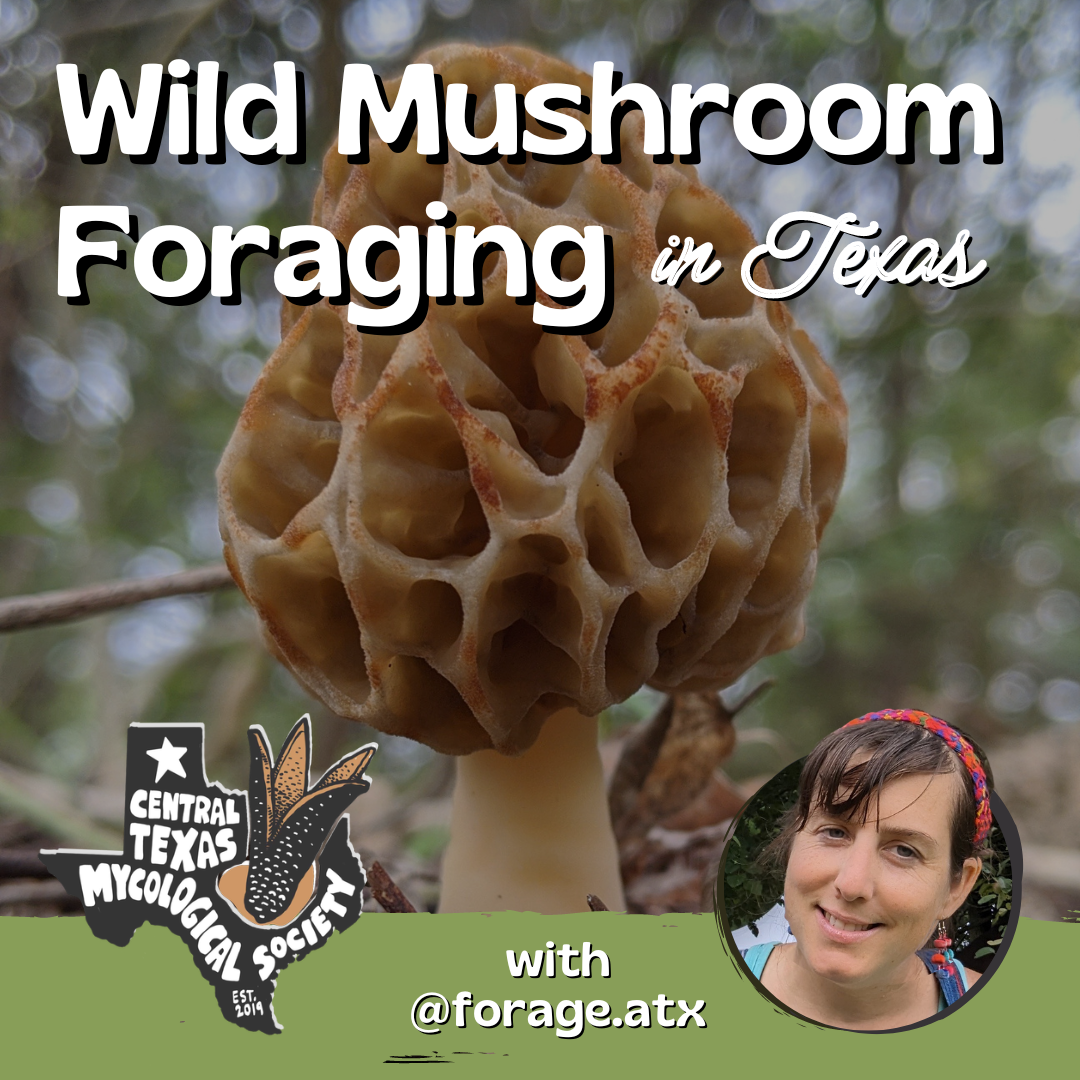
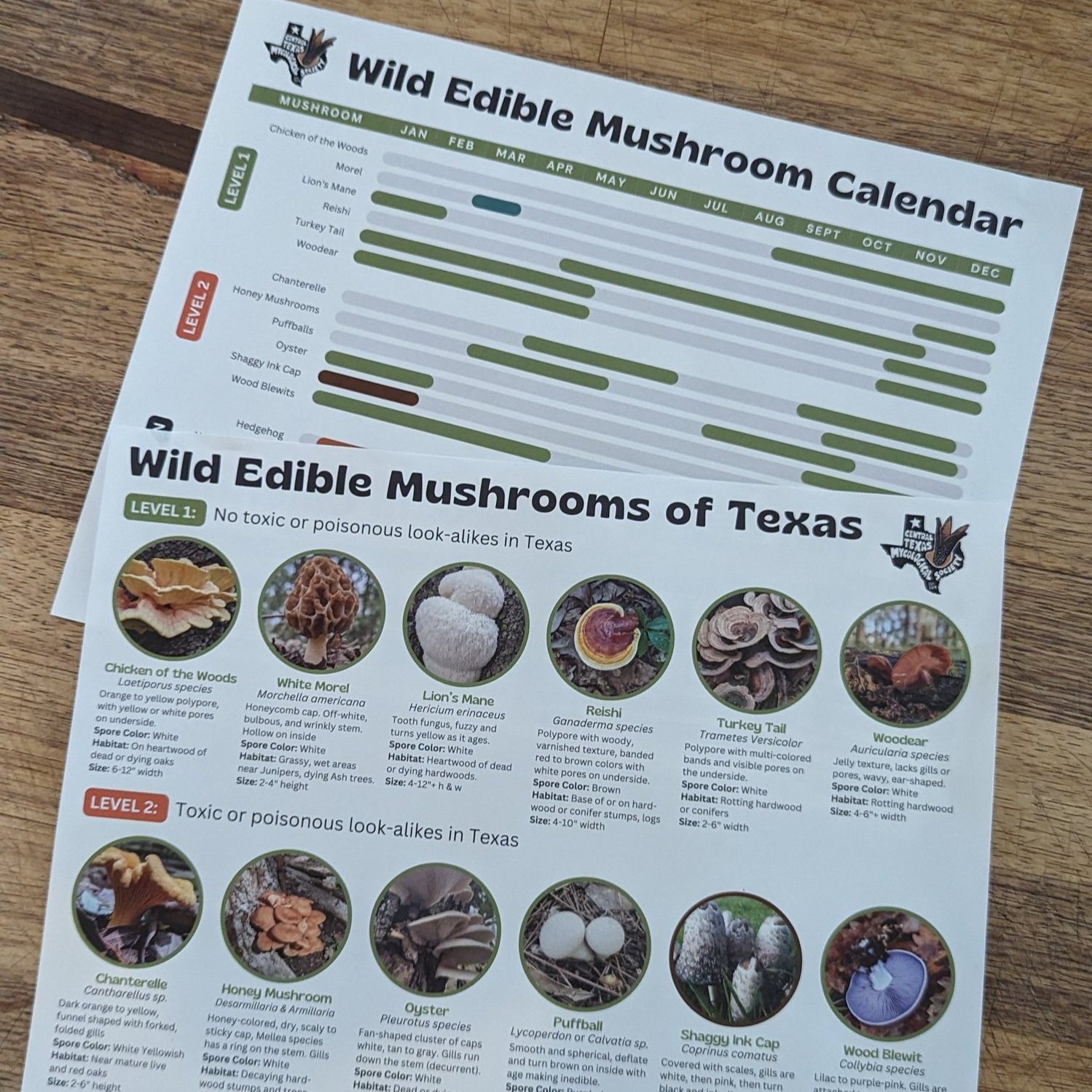
Chicken of the Woods: Laetiporus, 4 species in texas
DESCRIPTION: Orange to yellow polypore, with yellow or white pores on underside.
Habitat: Grows in shelfs on heartwood of dead or dying oaks.
Spore Color: White Size: 6-12" width
Edibility: Contains proteins, fat, fiber and tastes just like chicken! Harvest when young, colorful, and moist. Becomes lighter in color, fiborus, mealy and dry, inedible with age.
Look-alikes: Shaggy Bracket, Inonotus hispidus (non-toxic)
Ringless Honey Mushroom: Desarmillaria & ArmillariA Species
Ringless Honey Mushroom, Desarmillaria caespitosa will start been popping up all over Austin in large clusters at the bases of trees (when the clusters appear to be terrestrial they are actually growing from underground wood) in late summer and fall. This parasitic fungus is part of a genus that is the largest living organism ever found on this planet.
Description: Honey-colored, dry, scaly to sticky cap. Mellea species has a ring on the stem. Gills, some species have a ring.
Habitat: Grows in clusters on decaying hard-wood.
Spore Color: White
Size: 6" in Height
Edibility: Not Choice.
Look-alikes: Southern Jack-o-lantern, Omphalotus subilludens which is toxic and orange to brown in color.
REISHI: Ganoderma, 12 species in Texas
DESCRIPTION: Polypore with woody, varnished texture, banded red to brown colors with white pores on underside.
HABITAT: Grows at base or on hardwood stumps, logs, especially oaks and pecan. Pines in East Texas.
SPORE COLOR: Brown
SIZE: 4-10" width
EDIBILITY: Medicinal. Very bitter because of medicinal compounds.
LOOK-ALIKES: Red-Belted Conk, Fomitosis Pinicola (also medicinal).
honeycomb fungus: FavoluS 3 species in Texas
DESCRIPTION: Genus of tropical fungi in the family Polyporaceae but with fleshy with radially arranged pores on the underside of the cap that are angular and deeply pitted, somewhat resembling a honeycomb. White to yellow and grows alone or in overlapping clusters similar to oyster mushrooms or other shelf fungi.
HABITAT: On decaying hard-wood, year round when humidity is high after rain.
SPORE COLOR: White
SIZE: 3-6" wide
EDIBILITY: Odor slightly foul, especially in rehydrated material; taste not distinctive. Tough texture and can be cooked like chicharrones.
LOOK A-LIKE: Oysters, Pluerotus or Lentinellus cochleatus (none observed in Texas) but grow on decomposing wood.
WOOD EAR: Auricularia 6+- species in Texas
DESCRIPTION: Brown to amber in color. Jelly texture that is irregular, wavy, and ear-shaped. Lacks gills or pores.
HABITAT: Grows in clusters on decaying hardwood after rain
SPORE COLOR: White
SIZE: 4-6" in width and > 1/4" thick
EDIBILITY: Wood ear mushrooms are a popular ingredient in many Chinese dishes, such as hot and sour soup, and also used in Chinese medicine. It is also used in Ghana, as a blood tonic. Modern research into possible medical applications has variously concluded that wood ear has anti-tumor, hypoglycemic, anticoagulant and cholesterol-lowering properties.
LOOK-ALIKES: Amber Jelly, Exidia recisa which is also edible.
Puffball: Lycoperdon and Calvatia, 15+- species in Texas
DESCRIPTION: Smooth and spherical, deflate and turn purplish or brown on inside with age making inedible. Some peal and have spines.
HABITAT: Overgrazed Prairie or grasslands.
SPORE COLOR: Purple-brown
SIZE: 2- 60" diameter
EDIBILITY: Doesn’t have a strong flavor of its own and absorb flavors. Try making a Giant Puffball Pizza.
LOOK-ALIKES: Amanita species which can contain toxins and be fatal. If center of puffball is not white, it can cause GI distress.
Blue Milkcap: Lactarius Indigo
DESCRIPTION: Blue cap with concentric rings and a depression in center, sticky or slimy to the touch. Brittle flesh, stem. Gills and body exude blue latex when injured tissue is and stains the wounded tissue greenish blue.
HABITAT: Mycorrhizal and grows in deciduous and coniferous forests.
SPORE COLOR: Cream
SIZE: 2.0–5.9" cap width
EDIBILITY: Choice. Peppery taste and has a coarse, grainy texture.
LOOK-ALIKES: Blewit, Collybia nuda or Lactarius paradoxus (edible)
CHANTERELLE: Cantharellus, 10+- species in Texas
DESCRIPTION: Red, orange, yellow to white, meaty and funnel-shaped and can be found in clusters or individual mushrooms. On the lower surface, underneath the smooth cap, most species have rounded, forked folds that run almost all the way down the stipe, which tapers down seamlessly from the cap.
HABITAT: Symbiotic and found around 5-30 feet of mature live and red oaks after a lot of rain. Chanterelles need a lot of rain to fruit and they like the torrential Texas-style flash floods. Trees near creeks and where water is flowing downhill is very important. Avoid trees that are in areas that are mowed. Trees with undisturbed leaf matter and not many understory plants are ideal.
SPORE COLOR: White Yellowish
SIZE: 2-6" height
EDIBILITY: Choice. Many species emit a fruity aroma, reminiscent of apricots, and often have a mildly peppery taste.
LOOK A-LIKE: The Southern Jack-o-lantern, Omphalotus subilludens is the toxic look-a-like and is orange to brown in color. They do grow at the same time but their habitat and morphology is different.
OYSTER: Pleurotus ostreatus
DESCRIPTION: Color can vary white, tan and gray.White to cream gills, run down stem.
HABITAT: Grows in clusters and decomposes hardwood.
SPORE COLOR: White
SIZE: Cap fan shaped, 2"-8" across.
EDIBILITY: Choice. Delicious meat replacement in all types of cuisines
LOOK A-LIKE: The Southern Jack-o-lantern, Omphalotus subilludens is the toxic look-a-like and is orange to brown in color. They do grow at the same time but their habitat and morphology is different.
TURKEY TAIL Trametes versicolor
DESCRIPTION: Variable coloration, distinct striping pattern. No gills, pores are small and round, white to light brown
HABITAT: Grows in overlapping clusters on logs and stumps
SPORE COLOR: White
SIZE: Cap fan shaped, 2"-8" across.
EDIBILITY: Medicinal. Tough, leathery flesh. Can be brewed into a tea, broth, or extracted into a tincture.
LOOK A-LIKE: False turkey tail. or Stereum ostrea and is non-toxic. Mushroom Expert has a useful check list to determine if it is true medicinal turkey tail.
Become a member and learn more about wild mushroom foraging in Texas!
Membership benefits include early access and discounts to walks, workshops, and more. Your membership helps support the larger community! Tag us to get help with ID and add your observations to iNaturalist.org. If you are trying a new mushroom, confirm the ID with an expert, then try a small amount to make sure you don't have an allergic reaction. Texas Mushroom Identification Facebook group is great for quick responses and ID help. Also, don't forget to add your finds on the Mushrooms of Texas project on iNaturalist.
Follow my adventures @forage.atx.
September Mushroom of the Month: 𝘗𝘪𝘴𝘰𝘭𝘪𝘵𝘩𝘶𝘴 𝘢𝘳𝘩𝘪𝘻𝘶𝘴
The Mushroom of the Month for September is the, 𝘗𝘪𝘴𝘰𝘭𝘪𝘵𝘩𝘶𝘴 𝘢𝘳𝘩𝘪𝘻𝘶𝘴





🌈🐶💩The September mushroom of the month is the 𝘗𝘪𝘴𝘰𝘭𝘪𝘵𝘩𝘶𝘴 𝘢𝘳𝘩𝘪𝘻𝘶𝘴, colloquial names - Dead Man’s Foot, Bohemian truffle and Dog Turd Fungus, used for dyeing fabric and is also a mycorrhizal inoculate and helps plants establish roots. Swipe to learn more about this fascinating mushroom.
🙌 to @chaoticmessy for naming that mushroom correctly and becoming the 1,301th member of Central Texas Mycology!
Become a supporting member to stay dialed-in with events & discover next month’s mystery mushroom.
What is that thing?
Many people find themselves asking this question when coming across Pisolithus in the wild, which has led to it being called by many interesting colloquial names - Dead Man’s Foot, Bohemian truffle and Dog Turd Fungus, to name a few. It is a prolific species that occurs worldwide, sometimes growing by itself and other times mycorrhizal with pine, oaks and cedars. The fruiting body is 5–30 cm tall and 4–20 cm wide, with a thin yellow-brown to brown exterior layer and the spores are brown.
natural colors with Pisolithus
The common name of Dyeball refers to the traditional use of this fungus as a natural dye for textiles. Pisolithus starts out as a club-shaped dark brown object, that when cut open shows those ‘peas’ — little compartments in which the spores are formed, resembling what has been described as ‘rice crispies in tar’. In this stage, the mushroom is firm, wet, and will stains whatever it touches. In the next phase the top matures, the outer wall disintegrates and a dark chocolate brown dry spore mass is visible. The spores have pigmented hydrophobic walls, making them effective for long distance travel and also a powerful coloring agent.
is it edible?
While the Dyeball is not an edible mushroom for humans, it is highly nutritious for plants, especially trees! Because it forms mycorrhizas with almost any kind of root, this ectomycorrhizal fungus is frequently used by foresters (and in recent years by gardeners, too) as the basis of a soil inoculant to promote tree and plant growth - particularly in remediation of areas of degraded or polluted land or formerly clear-felled forest sites.
BECOME A SUPPORTING MEMBER & stay Dialed in with events & discover next month’s mystery mushroom
September Foraging Forecast
Learn wild, edible mushrooms fruiting in Texas after rain.
Learn wild, edible mushrooms fruiting in Texas after rain.
Comes with download of a Wild Edible Mushroom Calendar.


Huitlacoche: Mycosarcoma maydis
DESCRIPTION: Called “corn smut” and considered a pathogen by most U.S. farmers. In Latin America it is a delicacy, rooted in indigenous cultures who intentionally grow the fungus as a complete source of nutrition.
Habitat: Heirloom Corn
Spore Color: Black
Size: ½ to 11 inches, kernels to swell up to 10 times their normal size
Edibility: Delicate, earthy flavor that compares to truffles.
Look-alikes: None
LEARN ABOUT OUR Huitlacoche GROWING EXPERIMENT.
Chicken of the Woods: Laetiporus, 4 species in texas
DESCRIPTION: Orange to yellow polypore, with yellow or white pores on underside.
Habitat: Grows in shelfs on heartwood of dead or dying oaks.
Spore Color: White Size: 6-12" width
Edibility: Contains proteins, fat, fiber and tastes just like chicken! Harvest when young, colorful, and moist. Becomes lighter in color, fiborus, mealy and dry, inedible with age.
Look-alikes: Shaggy Bracket, Inonotus hispidus (non-toxic)
REISHI: Ganoderma, 12 species in Texas
DESCRIPTION: Polypore with woody, varnished texture, banded red to brown colors with white pores on underside.
HABITAT: Grows at base or on hardwood stumps, logs, especially oaks and pecan. Pines in East Texas.
SPORE COLOR: Brown
SIZE: 4-10" width
EDIBILITY: Medicinal. Very bitter because of medicinal compounds.
LOOK-ALIKES: Red-Belted Conk, Fomitosis Pinicola (also medicinal).
honeycomb fungus: FavoluS 3 species in Texas
DESCRIPTION: Genus of tropical fungi in the family Polyporaceae but with fleshy with radially arranged pores on the underside of the cap that are angular and deeply pitted, somewhat resembling a honeycomb. White to yellow and grows alone or in overlapping clusters similar to oyster mushrooms or other shelf fungi.
HABITAT: On decaying hard-wood, year round when humidity is high after rain.
SPORE COLOR: White
SIZE: 3-6" wide
EDIBILITY: Odor slightly foul, especially in rehydrated material; taste not distinctive. Tough texture and can be cooked like chicharrones.
LOOK A-LIKE: Oysters, Pluerotus or Lentinellus cochleatus (none observed in Texas) but grow on decomposing wood.
WOOD EAR: Auricularia 6+- species in Texas
DESCRIPTION: Brown to amber in color. Jelly texture that is irregular, wavy, and ear-shaped. Lacks gills or pores.
HABITAT: Grows in clusters on decaying hardwood after rain
SPORE COLOR: White
SIZE: 4-6" in width and > 1/4" thick
EDIBILITY: Wood ear mushrooms are a popular ingredient in many Chinese dishes, such as hot and sour soup, and also used in Chinese medicine. It is also used in Ghana, as a blood tonic. Modern research into possible medical applications has variously concluded that wood ear has anti-tumor, hypoglycemic, anticoagulant and cholesterol-lowering properties.
LOOK-ALIKES: Amber Jelly, Exidia recisa which is also edible.
Puffball: Lycoperdon and Calvatia, 15+- species in Texas
DESCRIPTION: Smooth and spherical, deflate and turn purplish or brown on inside with age making inedible. Some peal and have spines.
HABITAT: Overgrazed Prairie or grasslands.
SPORE COLOR: Purple-brown
SIZE: 2- 60" diameter
EDIBILITY: Doesn’t have a strong flavor of its own and absorb flavors. Try making a Giant Puffball Pizza.
LOOK-ALIKES: Amanita species which can contain toxins and be fatal. If center of puffball is not white, it can cause GI distress.
Blue Milkcap: Lactarius Indigo
DESCRIPTION: Blue cap with concentric rings and a depression in center, sticky or slimy to the touch. Brittle flesh, stem. Gills and body exude blue latex when injured tissue is and stains the wounded tissue greenish blue.
HABITAT: Mycorrhizal and grows in deciduous and coniferous forests.
SPORE COLOR: Cream
SIZE: 2.0–5.9" cap width
EDIBILITY: Choice. Peppery taste and has a coarse, grainy texture.
LOOK-ALIKES: Blewit, Collybia nuda or Lactarius paradoxus (edible)
CHANTERELLE: Cantharellus, 10+- species in Texas
DESCRIPTION: Red, orange, yellow to white, meaty and funnel-shaped and can be found in clusters or individual mushrooms. On the lower surface, underneath the smooth cap, most species have rounded, forked folds that run almost all the way down the stipe, which tapers down seamlessly from the cap.
HABITAT: Symbiotic and found around 5-30 feet of mature live and red oaks after a lot of rain. Chanterelles need a lot of rain to fruit and they like the torrential Texas-style flash floods. Trees near creeks and where water is flowing downhill is very important. Avoid trees that are in areas that are mowed. Trees with undisturbed leaf matter and not many understory plants are ideal.
SPORE COLOR: White Yellowish
SIZE: 2-6" height
EDIBILITY: Choice. Many species emit a fruity aroma, reminiscent of apricots, and often have a mildly peppery taste.
LOOK A-LIKE: The Southern Jack-o-lantern, Omphalotus subilludens is the toxic look-a-like and is orange to brown in color. They do grow at the same time but their habitat and morphology is different.
OYSTER: Pleurotus ostreatus
DESCRIPTION: Color can vary white, tan and gray.White to cream gills, run down stem.
HABITAT: Grows in clusters and decomposes hardwood.
SPORE COLOR: White
SIZE: Cap fan shaped, 2"-8" across.
EDIBILITY: Choice. Delicious meat replacement in all types of cuisines
LOOK A-LIKE: The Southern Jack-o-lantern, Omphalotus subilludens is the toxic look-a-like and is orange to brown in color. They do grow at the same time but their habitat and morphology is different.
TURKEY TAIL Trametes versicolor
DESCRIPTION: Variable coloration, distinct striping pattern. No gills, pores are small and round, white to light brown
HABITAT: Grows in overlapping clusters on logs and stumps
SPORE COLOR: White
SIZE: Cap fan shaped, 2"-8" across.
EDIBILITY: Medicinal. Tough, leathery flesh. Can be brewed into a tea, broth, or extracted into a tincture.
LOOK A-LIKE: False turkey tail. or Stereum ostrea and is non-toxic. Mushroom Expert has a useful check list to determine if it is true medicinal turkey tail.
Become a member and learn more about wild mushroom foraging in Texas!
Membership benefits include early access and discounts to walks, workshops, and more. Your membership helps support the larger community! Tag us to get help with ID and add your observations to iNaturalist.org. If you are trying a new mushroom, confirm the ID with an expert, then try a small amount to make sure you don't have an allergic reaction. Texas Mushroom Identification Facebook group is great for quick responses and ID help. Also, don't forget to add your finds on the Mushrooms of Texas project on iNaturalist.
Follow my adventures @forage.atx.
August Mushroom of the Month: Flower Pot Parasol
The Mushroom of the Month for August is the Flower Pot Parasol, Leucocoprinus birnbaumii





🔥The August mushroom of the month is the Leucocoprinus birnbaumii, commonly known as the Flower Pot Parasol, a saprophytic fungi native to the tropics. In recent times it has become common in greenhouses and indoor plants in temperate regions, its spores having hitched rides in the tropical plant trade.
🙌 to Aerie for naming that mushroom correctly and becoming the newest member of Central Texas Mycology!
Why the name?
The Flower Pot Parasol, aka yellow parasol, flowerpot parasol, or plantpot dapperling, is a species of gilled mushroom in the family Agaricaceae. It is common in the tropics and subtropics but in temperate regions it frequently occurs in greenhouses and flowerpots, hence its common names.
how did it get into my flower pot?
The Flower Pot Parasol was first described in 1788 by English mycologist James Bolton who described an observation from a hothouse near Halifax, three years earlier in 1785. During this era, exotic plants from tropical areas were being brought to and cultivated in greenhouses and gardens from the East Indies and India, so it is likely the spores hitched a ride in the soil or mulch.
is it edible?
Although the Flower Pot Parasol does look beautiful it is not edible. Though it will not kill you, it will cause some very unpleasant gastrointestinal irritation. However, it may have medicinal uses. A 2015 study showed that fatty acids extracted from Leucocoprinus birnbaumii have moderate but selective anti-microbial effects.
BECOME A SUPPORTING MEMBER & stay Dialed in with events & discover next month’s mystery mushroom
August Foraging Forecast
Learn wild, edible mushrooms fruiting in Texas after rain.
Learn wild, edible mushrooms fruiting in Texas after rain.
Comes with download of a Wild Edible Mushroom Calendar.


Chicken of the Woods: Laetiporus, 4 species in texas
Orange to yellow polypore, with yellow or white pores on underside.
Habitat: Grows in shelfs on heartwood of dead or dying oaks.
Spore Color: White Size: 6-12" width
Edibility: Contains proteins, fat, fiber and tastes just like chicken! Harvest when young, colorful, and moist. Becomes lighter in color, fiborus, mealy and dry, inedible with age.
Look-alikes: Shaggy Bracket, Inonotus hispidus (non-toxic)
Huitlacoche: Mycosarcoma maydis
Called “corn smut” and considered a pathogen by most U.S. farmers. In Latin America it is a delicacy, rooted in indigenous cultures who intentionally grow the fungus as a complete source of nutrition.
Habitat: Heirloom Corn
Spore Color: Black
Size: ½ to 11 inches, kernels to swell up to 10 times their normal size
Edibility: Delicate, earthy flavor that compares to truffles.
Look-alikes: None
LEARN ABOUT OUR Huitlacoche GROWING EXPERIMENT.
REISHI: Ganoderma, 12 species in Texas
Polypore with woody, varnished texture, banded red to brown colors with white pores on underside.
HABITAT: Grows at base or on hardwood stumps, logs, especially oaks and pecan. Pines in East Texas.
SPORE COLOR: Brown
SIZE: 4-10" width
EDIBILITY: Medicinal. Very bitter because of medicinal compounds.
LOOK-ALIKES: Red-Belted Conk, Fomitosis Pinicola (also medicinal).
honeycomb fungus: FavoluS 3 species in Texas
Genus of tropical fungi in the family Polyporaceae but with fleshy with radially arranged pores on the underside of the cap that are angular and deeply pitted, somewhat resembling a honeycomb. White to yellow and grows alone or in overlapping clusters similar to oyster mushrooms or other shelf fungi.
HABITAT: On decaying hard-wood, year round when humidity is high after rain.
SPORE COLOR: White
SIZE: 3-6" wide
EDIBILITY: Odor slightly foul, especially in rehydrated material; taste not distinctive. Tough texture and can be cooked like chicharrones.
LOOK A-LIKE: Oysters, Pluerotus or Lentinellus cochleatus (none observed in Texas) but grow on decomposing wood.
WOOD EAR: Auricularia 6+- species in Texas
Brown to amber in color. Jelly texture that is irregular, wavy, and ear-shaped. Lacks gills or pores.
HABITAT: Grows in clusters on decaying hardwood after rain
SPORE COLOR: White
SIZE: 4-6" in width and > 1/4" thick
EDIBILITY: Wood ear mushrooms are a popular ingredient in many Chinese dishes, such as hot and sour soup, and also used in Chinese medicine. It is also used in Ghana, as a blood tonic. Modern research into possible medical applications has variously concluded that wood ear has anti-tumor, hypoglycemic, anticoagulant and cholesterol-lowering properties.
LOOK-ALIKES: Amber Jelly, Exidia recisa which is also edible.
Puffball: Lycoperdon and Calvatia, 15+- species in Texas
Smooth and spherical, deflate and turn purplish or brown on inside with age making inedible. Some peal and have spines.
HABITAT: Overgrazed Prairie or grasslands.
SPORE COLOR: Purple-brown
SIZE: 2- 60" diameter
EDIBILITY: Doesn’t have a strong flavor of its own and absorb flavors. Try making a Giant Puffball Pizza.
LOOK-ALIKES: Amanita species which can contain toxins and be fatal. If center of puffball is not white, it can cause GI distress.
Blue Milkcap: Lactarius Indigo
Blue cap with concentric rings and a depression in center, sticky or slimy to the touch. Brittle flesh, stem. Gills and body exude blue latex when injured tissue is and stains the wounded tissue greenish blue.
HABITAT: Mycorrhizal and grows in deciduous and coniferous forests.
SPORE COLOR: Cream
SIZE: 2.0–5.9" cap width
EDIBILITY: Choice. Peppery taste and has a coarse, grainy texture.
LOOK-ALIKES: Blewit, Collybia nuda or Lactarius paradoxus (edible)
CHANTERELLE: Cantharellus, 10+- species in Texas
DESCRIPTION: Red, orange, yellow to white, meaty and funnel-shaped and can be found in clusters or individual mushrooms. On the lower surface, underneath the smooth cap, most species have rounded, forked folds that run almost all the way down the stipe, which tapers down seamlessly from the cap.
SPORE COLOR: White Yellowish
HABITAT: Symbiotic and found around 5-30 feet of mature live and red oaks after a lot of rain. Chanterelles need a lot of rain to fruit and they like the torrential Texas-style flash floods. Trees near creeks and where water is flowing downhill is very important. Avoid trees that are in areas that are mowed. Trees with undisturbed leaf matter and not many understory plants are ideal.
SIZE: 2-6" height
EDIBILITY: Choice. Many species emit a fruity aroma, reminiscent of apricots, and often have a mildly peppery taste.
LOOK A-LIKE: The Southern Jack-o-lantern, Omphalotus subilludens is the toxic look-a-like and is orange to brown in color. They do grow at the same time but their habitat and morphology is different.
Lobster mushroom, Hypomyces lactifluorum
Parasitic fungus that grows on certain species of mushrooms, turning them a reddish orange color that resembles the outer shell of a cooked lobster.
HABITAT: Grows in mixed woods where H. lactifluorum specifically attacks members of the genera Lactarius and Lactifluus (milk-caps), and Russula (brittlegills), such as Russula brevipes and Lactifluus piperatus in North America. At maturity, H. lactifluorum thoroughly covers its host, rendering it unidentifiable.
SPORE PRINT: White spore print
Edible with a subtle shellfish flavor that's easy to identify with no look alikes.
LOOK A-LIKE: The Southern Jack-o-lantern, Omphalotus subilludens is the toxic look-a-like and is orange to brown in color. They do grow at the same time but their habitat and morphology is different.
NOTE: I spotted this Lobster after we had torrential rain in 2019. Hypomyces may be parasitizing these mushrooms. Several members of the community have already seen them this year!
Become a member and learn more about wild mushroom foraging in Texas!
Membership benefits include early access and discounts to walks, workshops, and more. Your membership helps support the larger community! Tag us to get help with ID and add your observations to iNaturalist.org. If you are trying a new mushroom, confirm the ID with an expert, then try a small amount to make sure you don't have an allergic reaction. Texas Mushroom Identification Facebook group is great for quick responses and ID help. Also, don't forget to add your finds on the Mushrooms of Texas project on iNaturalist.
Follow my adventures @forage.atx.
July Mushroom of the Month: Southern Clam Shell, Fomes fasciatus
The July mushroom of the month is the 𝘍𝘰𝘮𝘦𝘴 𝘧𝘢𝘴𝘤𝘪𝘢𝘵𝘶𝘴





🔥The July mushroom of the month is the 𝘍𝘰𝘮𝘦𝘴 𝘧𝘢𝘴𝘤𝘪𝘢𝘵𝘶𝘴, commonly known as the Southern Clam Shell, a white rot fungi that grows in the Southeastern parts of North America and is a tinder conch and can be used to start fire.
🙌 to Eldon for naming that mushroom correctly and becoming the newest member of Central Texas Mycology!
WHAT IS IT?
The Southern Clam Shell, Fomes fasciatus, is a pathogenic white rot polypore fungus that grows on hardwood trees in southeastern North America, South and Central America. It has also been documented in Australia and Asia. It has a hard outer shell shaped like a clam or hoof, earning it the nickname ‘horse hoof’ fungus.
Traditional uses
The Southern Clam Shell has an interior trauma layer that can be harvested for tinder. The material, called Amadou, has been coveted since ancient times for its ability to start fires quickly even in inclement condi-tions. Otzi, the famous 5,300 year old mummy found frozen in the alps, was carrying Fomes fomentarius, the northern relative of the Southern Clam Shell, when he died.
FUTURE USES
Fomes fasciatus has also been researched as a potential cheap biosorbent of heavy metals due to its common occurrence and lack of current economic use. The research evaluated the dried and pulverized fruiting bodies ability to absorb Cu II (copper compounds) commonly found in wastewater and found that treating the prepared fungi with hot-alkali improved its sorbent properties.
BECOME A SUPPORTING MEMBER & stay Dialed in with events & discover next month’s mystery mushroom
June Mushroom of the Month: Ganoderma sessile
The June mushroom of the month is Ganoderma sessile or Reishi!
What is It?





Ganoderma sessile is a recently re-named species of Reishi found in north America. Previously it was known as Ganoderma lucidum, the species commonly referred to as Reishi found in Asia and Europe. However, recent genealogical evidence has indicated that the north American variety is a unique species.
WHAT CHANGED?
For many years, Ganoderma sessile was considered to be Ganoderma lucidum. Research published in 2018 by Loyd et al found that Ganoderma lucidum was in fact only native to two places in North America, Utah and northern Califorina, and is likely a non-native species introducted accidently by cultivators. Ganoderma sessile is a related species native to North America.
IS ALL REISHI THE SAME?
Species of Ganoderma, commonly called reishi (in Japan) or lingzhi (in China), have been used in traditional medicine for thousands of years. Research by Loyd et al has shown that products labeled as ‘reishi’ often contain a mix of species from this genus, including G. applanatum, G. australe, G. gibbosum, G. sessile, and G. sinense. There is likely differences between the species in terms of potency but more research is needed.
BECOME A SUPPORTING MEMBER & stay Dialed in with events & discover next month’s mystery mushroom
8 Ways to Learn to Identify & Forage Wild Mushrooms
We are in peak foraging season with the recent rain. We have several resources we recommend you check out.
We are in peak foraging season with the RECENT rain. We have several resources we recommend you check out.
🌐 Visit our website and take the online foraging mushrooms class. It comes with a foraging calendar download.
📝 Visit our blog for the latest foraging forecasts and tips on how to take photos of mushrooms for positive identification.
🥾 Check our calendar for upcoming mushroom walks we have a 🔦UV night walk coming up soon.
🔪 Check out the latest issue of Texas Monthly to learn about foraging wood blewits
🧺 The Texas Parks & Wildlife Magazine also has lots of great article in their March issue on foraging mushrooms.
♉ Join us at Texas Mushroom Conference late this month, forage.atx will be keynoting on Foraging Mushrooms in Texas.
🏷️ Tag us to get help with ID and add your observations to iNaturalist.org. If you are trying a new mushroom, confirm the ID with a human expert. Always cook, then try a small amount to make sure you don't have a reaction.
📋 Become a member and learn more about wild mushroom foraging in Texas! Membership benefits include early access and discounts to walks, workshops, and more. Your membership helps support the larger community!
May Mushroom of the Month: Favolus or Honeycomb Fungus
The May mushroom of the month is the tropical and edible Favolus species
What is It?





This genus of white rot fungus is saphrophytic with head hardwoods in Eurasia, Japan, Africa, Central and South America and the southern areas of North America. There are currently 25 distinct species within this genus, all sharing a distinct honeycomb shaped gill structure from which it derives its common name, honeycomb fungus.
Is it edible?
Honeycomb fungus is not considered a choice edible mostly because of the texture. However, in 2020 a paper was published on the commercial cultivation, nutrition and food potential of this tropical mushroom in the Amazon where it is native and collected by the Yanomami people, who already sell more than 10 Amazon mushroom species. You can learn more about their mushroom culture in this film by @beatrizmaues.
Foraging Tips
Look for honeycomb fungus on the trunks and base of dead and rotting hardwoods, such as oak and pecan in central and east Texas.The best time to harvest is when the fungus is soft and fresh, before they have begun to harden and turn yellow. Check this months foraging forecast on our blog for more tips on cooking with this shroom from @forage.atx!
BECOME A SUPPORTING MEMBER & stay Dialed in with events & discover next month’s mystery mushroom
A History of Circular Innovation: Repurposing Spent Spawn Blocks from Mushroom Farms in Austin, Texas
Daniel Reyes reflects on the 2013 origins of our block waste diversion program, it's a testament to the power of perseverance and community working to change the value of what is considered waste.
By: Daniel Reyes, co-founder of CTMS and founder of Myco Alliance
Join us online for a class with Daniel about Applied Mycology.
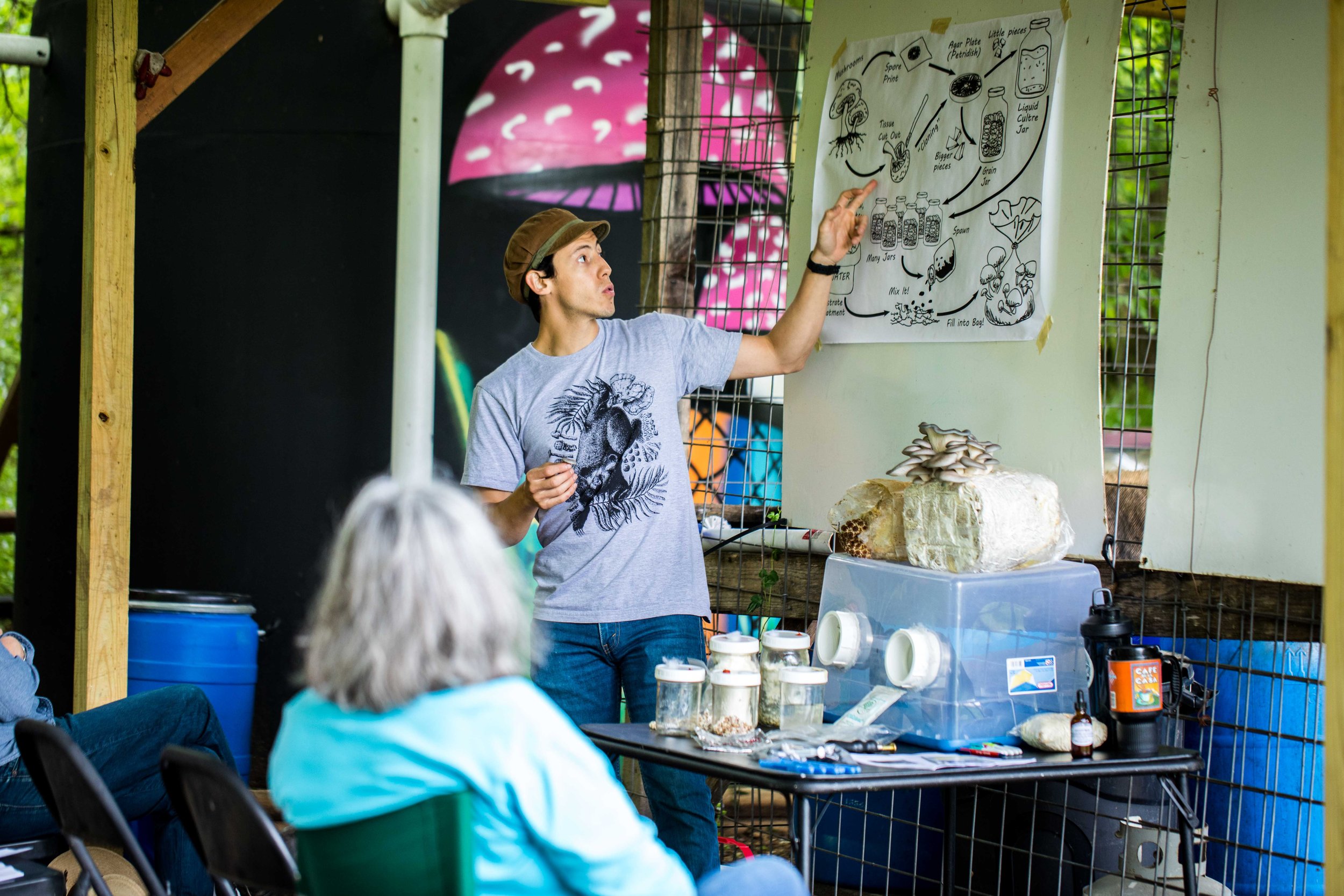
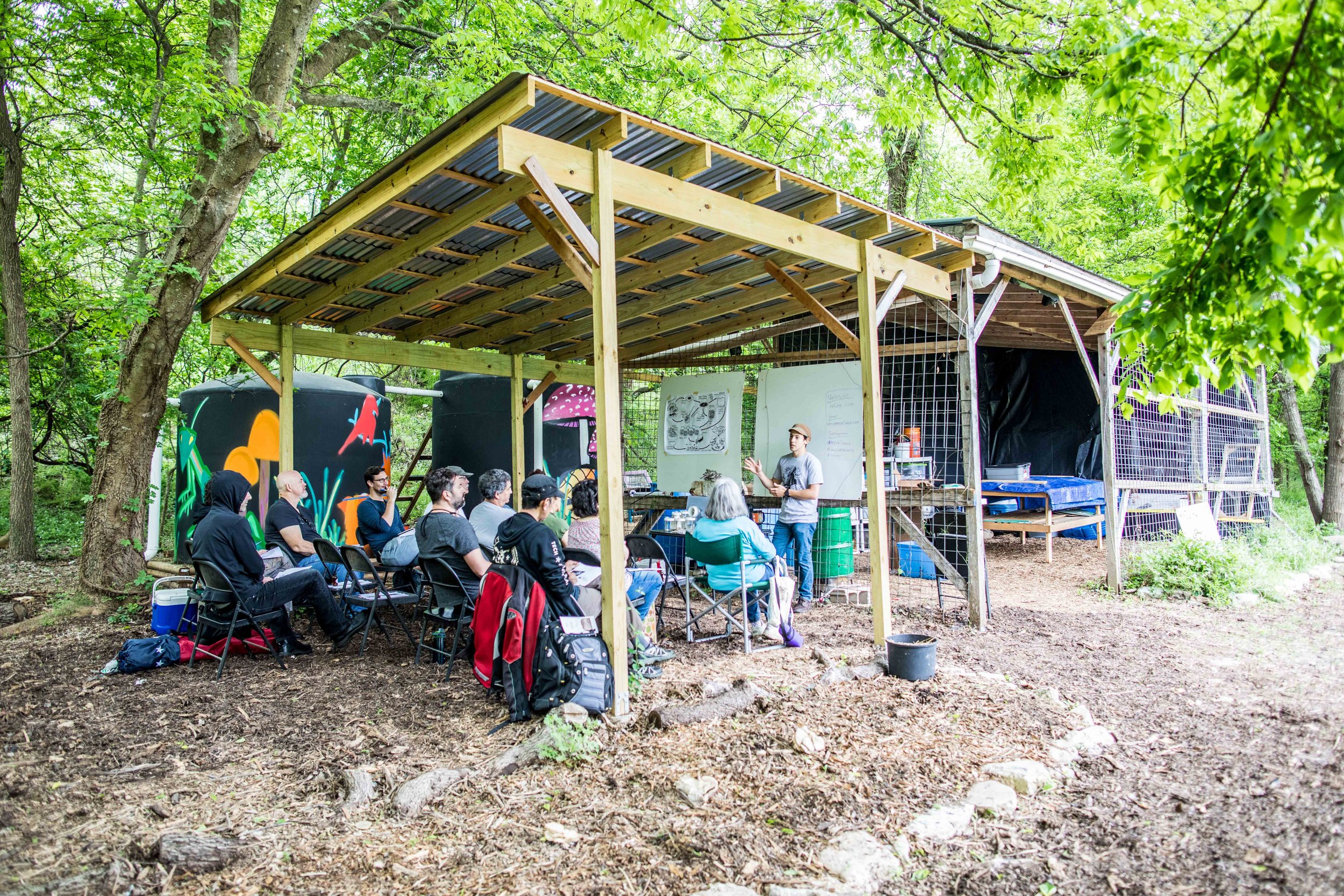
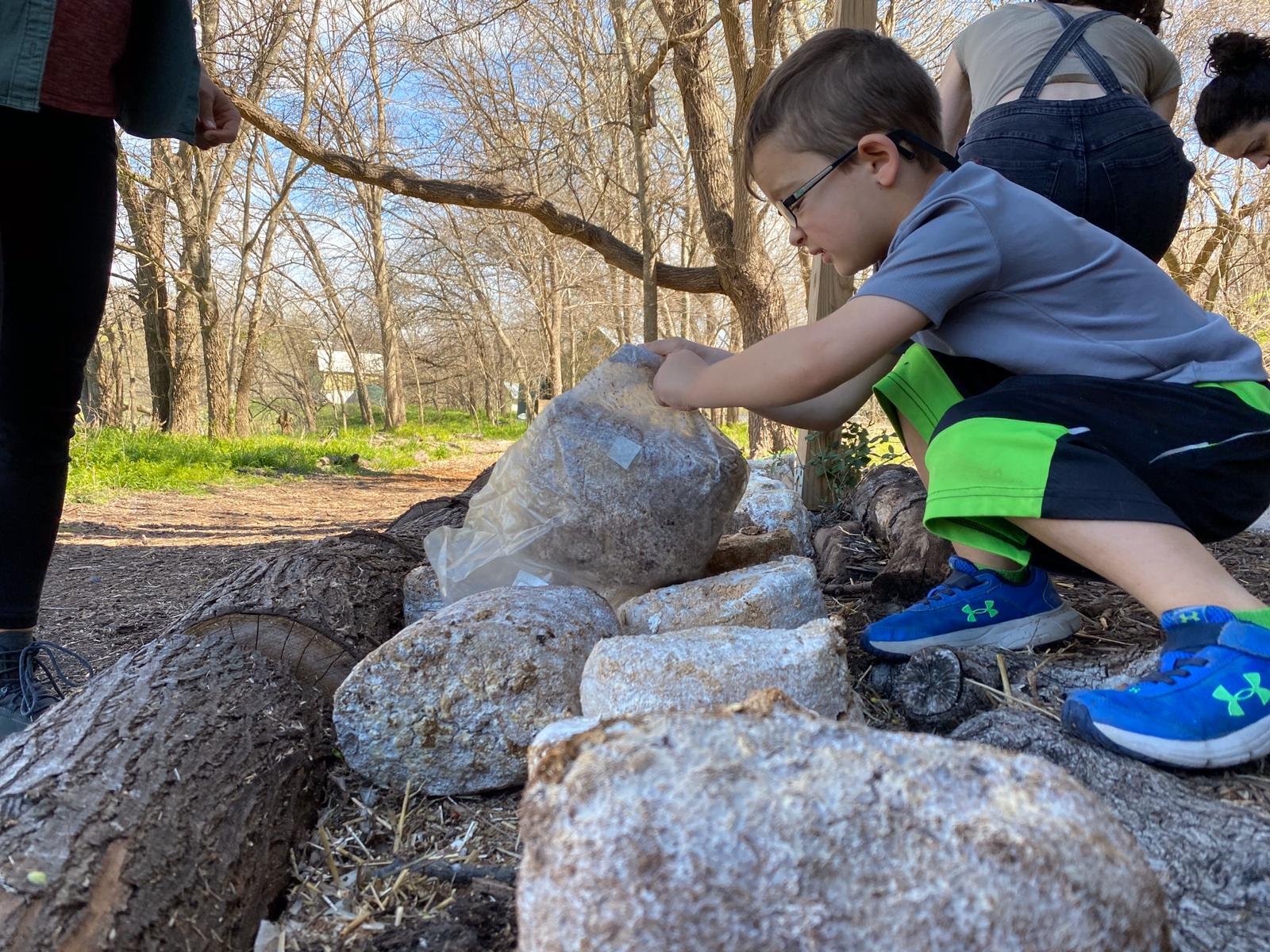
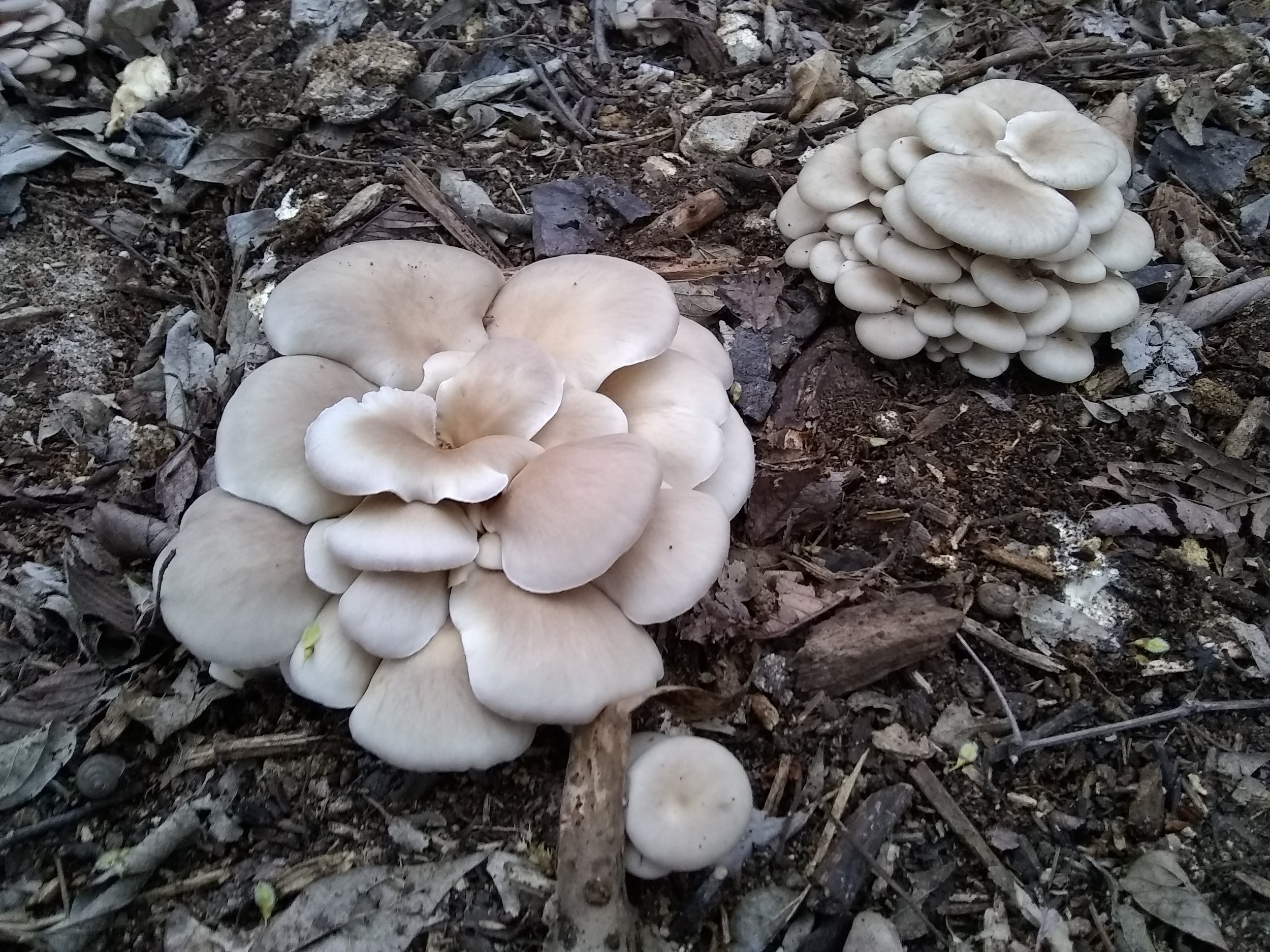
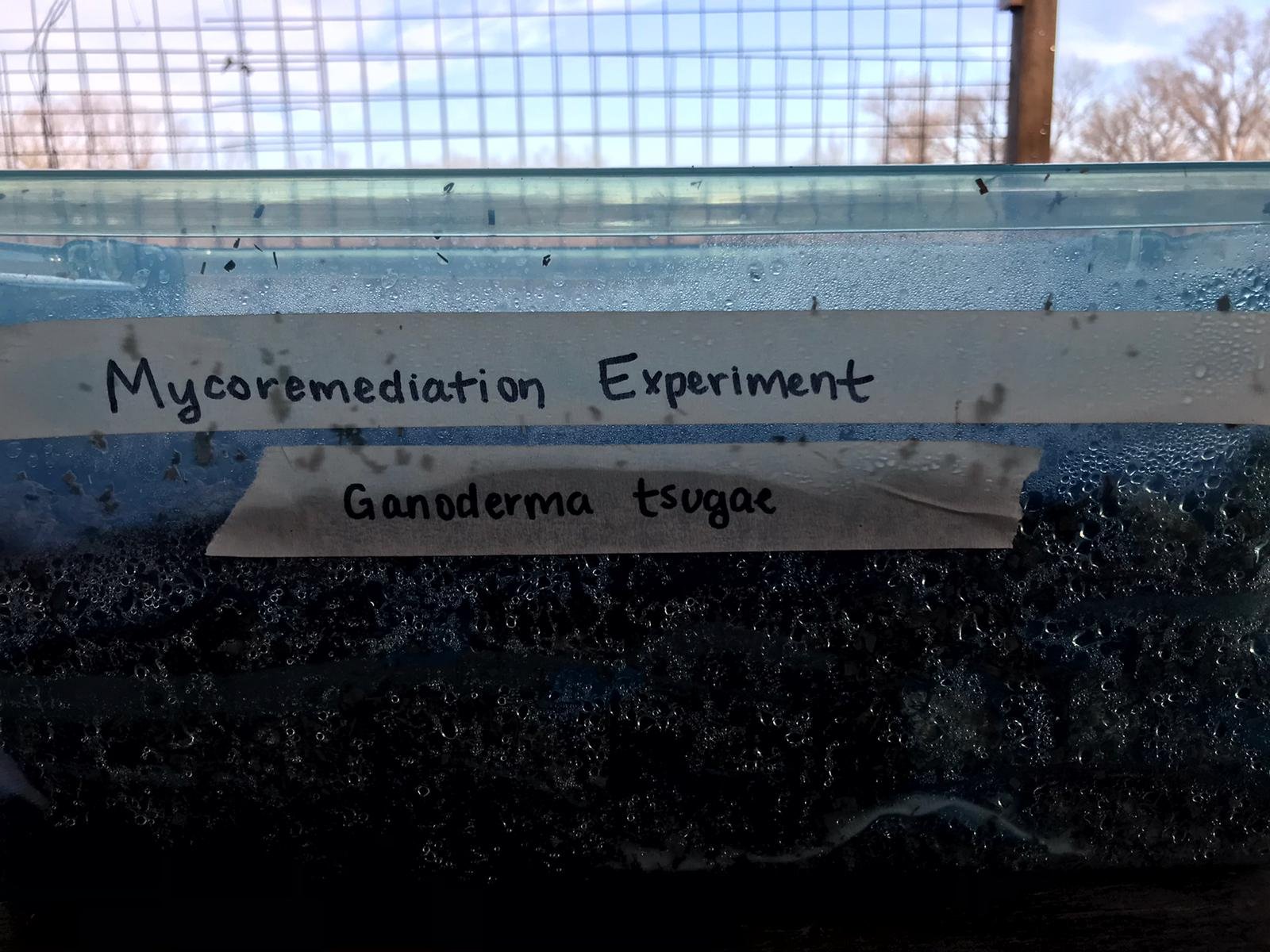
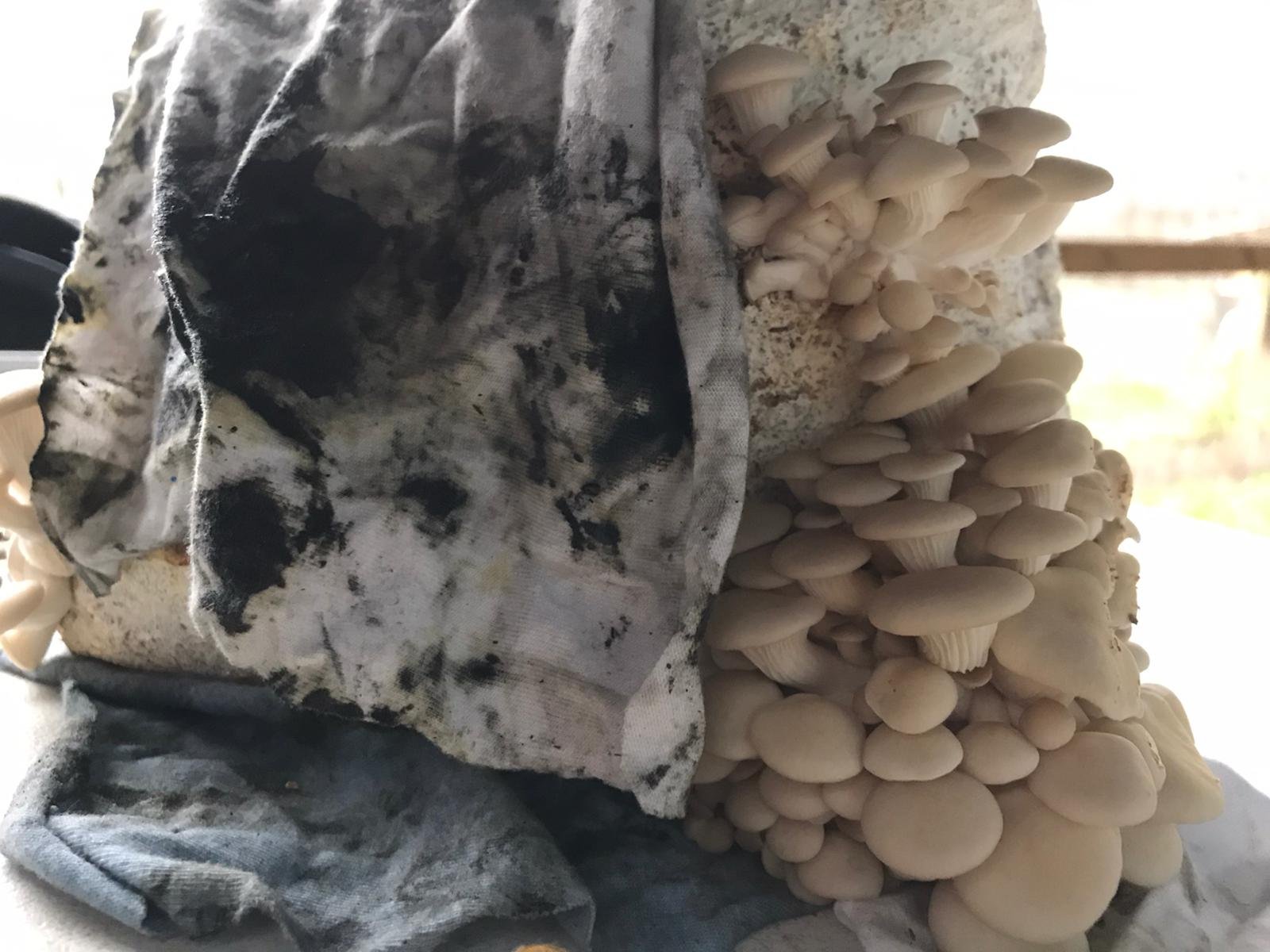
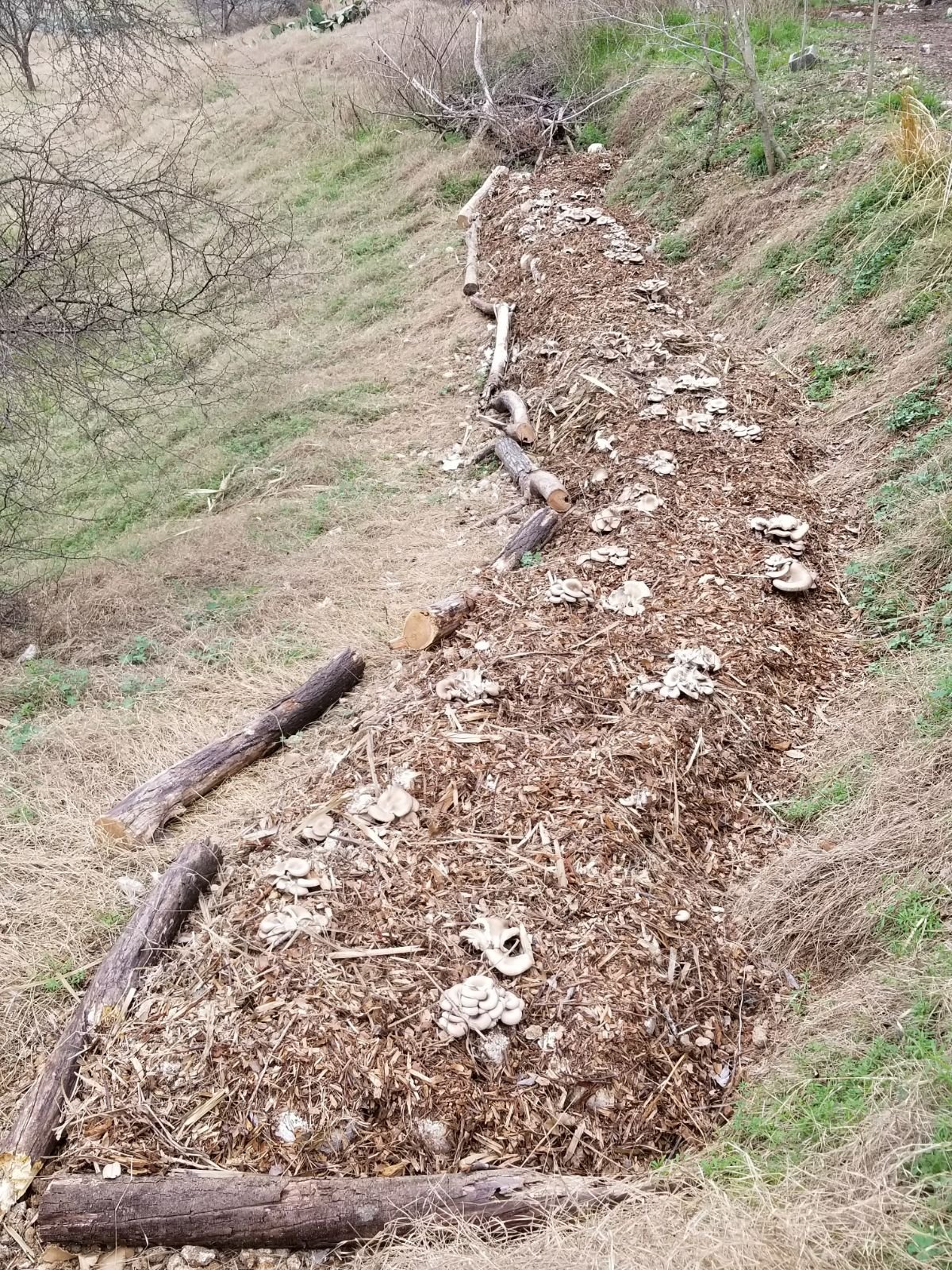
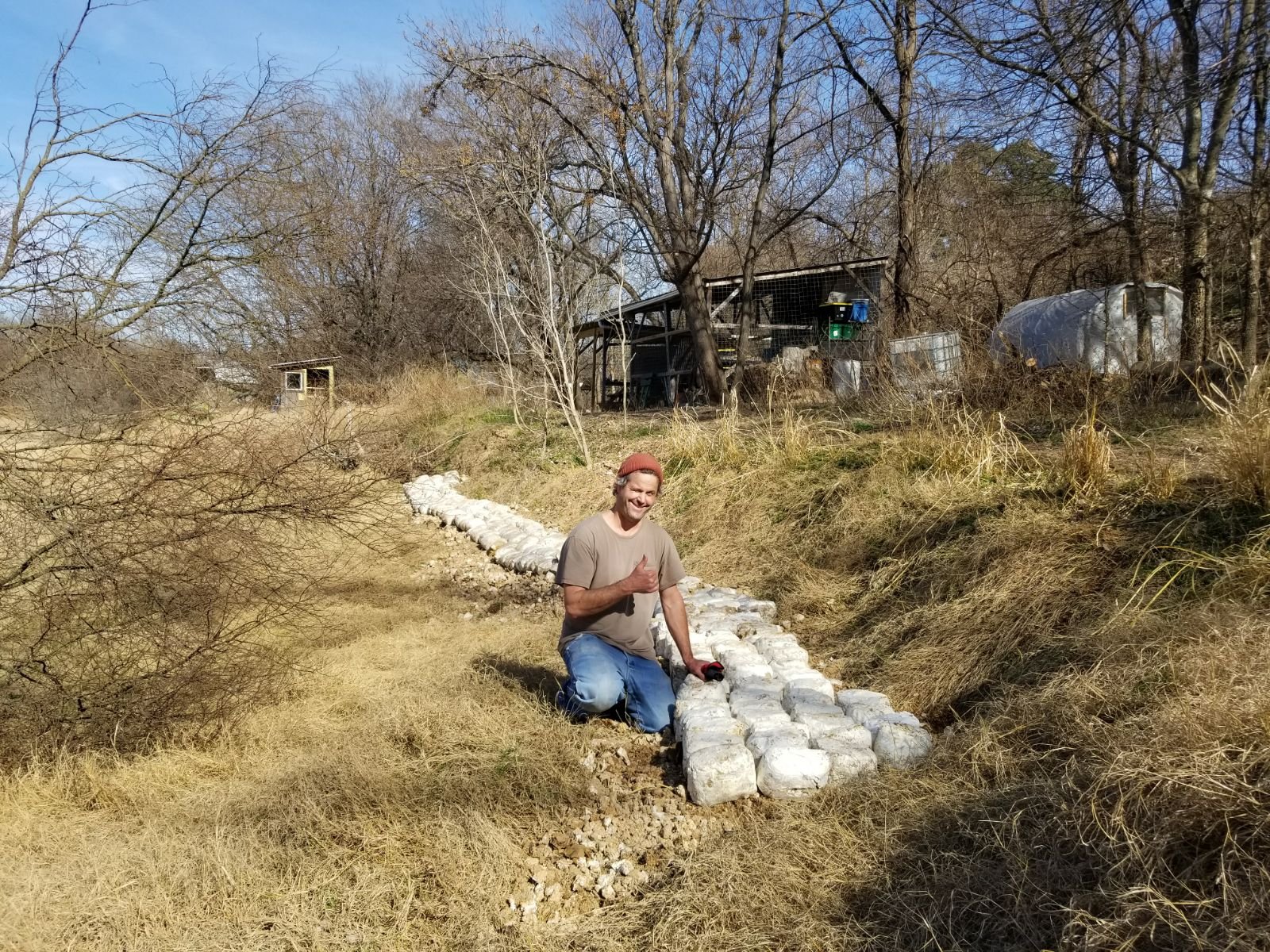
Back in 2013, while working as a hydrogeologist in the oil and gas industry, I reached out to my friend Mike Wolfert for advice on mushroom cultivation. Little did I know, this simple conversation would spark a massive change in the course of my career. Mike Wolfert, known for his work in regenerative agriculture and permaculture through organizations like Symbiosis TX (formerly One World Permaculture), became a key figure in my journey. Over the course of several months, I kept looking for opportunities to learn all I could about mycology while I kept my career job.
I did a lot of self learning until I heard about these guys out by Dripping Springs who were growing edible mushrooms. I started volunteering on the weekends at LoGro Farms, where I marveled at their innovative approach to sustainability. There, the circular economy was alive and thriving: Jester King Brewery sent their spent beer rains to LoGro, where they were repurposed as substrate for mushroom cultivation. LoGro then produced mushrooms from this waste, which became a key ingredient in tanley's pizza and a staple in Jester King's famous Snorkel mushroom beer. This closed-loop system not only minimized waste but also maximized resource efficiency, inspiring me to rethink waste management in the mushroom farming industry.
While volunteering at LoGro Farms, where sustainability thrived as a core principle, I stumbled upon a notable hurdle: spent mycelium blocks, cast aside after only a handful of harvests. As I observed the stacks of discarded mycelium blocks from the production of their mushroom kits, it became clear that there was more to their story than mere waste. These blocks, once bursting with life as a vital component of mushroom cultivation, now languished in neglect, awaiting their fate in the discard pile. Yet, amidst their apparent insignificance, I saw a hidden opportunity—an opportunity to breathe new life into these discarded remnants.
I went back to Mike and suggested we could put these discarded blocks to good use in a project. I explained how these blocks, instead of being thrown away, could be used to strengthen swales and berms. Mike was intrigued. We brainstormed ways to make it happen, considering how these blocks could improve soil health and help plants grow. By incorporating spent mycelium blocks into swales and berms, we aimed to enhance their functionality and ecological benefits. The mycelium, with its intricate network of hyphae, acts as a natural binder, strengthening soil structure and promoting water etention. As these blocks break down over time, they contribute organic matter and nutrients to the surrounding soil, enriching its fertility and supporting plant growth.
In pursuit of expanding my knowledge and impact in the realm of applied mycology and environmental remediation, I journeyed to the Ecuadorian Amazon basin later that year into the Sucumbios region. Drawing from my background in hydrogeology and having been recently inoculated with the ethos of circularity nurtured at LoGro Farms and guided by Mike's wisdom in permaculture practices, I endeavored to seamlessly intertwine these ideologies in the Ecuadorian context.
Navigating the complexities of Amazonian ecosystems and addressing environmental challenges. We initiated projects to strengthen resilience and promote sustainable living practices. One of the key challenges we faced was sourcing suitable spawn for our projects. While commercial strains were readily available in the capital city of Quito, they were ill-suited for the unique conditions of the Amazon. We recognized the importance of using native strains, tolerant to the region's environment, to ensure the success of our initiatives and for that reason began to work only with producers of native, resilient strains.
Against the backdrop of environmental degradation and industrial impact, we were acutely aware of the region's history, including the devastating legacy of Texaco's oil drilling operations in the Lago Agrio oil field. Texaco's irresponsible waste disposal practices in the 1960’s, amounting to billions of gallons of oil dumped into unlined pits, had left a lasting scar on the ecosystem, poisoning water supplies and threatening indigenous livelihoods.
In 2015, following my return from Ecuador, I initiated pioneering research through Myco Alliance LLC on the use of mycelium for bioremediation. It wasn’t until 2016, however, that a significant breakthrough occurred. Together with Ecology Action of Texas, we secured a $50k grant from the National Fish and Wildlife Foundation for the Montopolis Wetland and Creek Rehab Project. This project was centered at the Circle Acres Nature Preserve, once a capped landfill and now a 10-acre expanse of restored wetlands,forest, and grassland nestled within the southeast Austin neighborhood of Montopolis.
The acquisition of this grant and the subsequent construction of The Research Stationmarked a pivotal moment in our journey. It provided the impetus for the development of educational programming focused on waste diversion. What better place to lead such efforts than at an old landfill site?
Between 2016 and 2019, our educational initiatives at Myco Alliance flourished, particularly with the invaluable addition of Hi-Fi Mycology to the burgeoning Austin mycology scene in February of 2017. The collaboration with Cory and Sean was instrumental during those years, which would end up leading to the formation of the Central Texas Mycological Society in 2019. Those days though, on average, I along with volunteers, would pick up anywhere between 300-700 blocks per week from their farm near 183 and Burnett. Each block averages about 5 lbs so we were essentially diverging close to 1 ton of spent spawn per week and close to 50 tons of annual waste diverted from landfills. These blocks would instead end up at Circle Acres, at the mycological research station, and get used multiple times.
At our mycological research station at Circle Acres, the journey of these blocks took on various stages. Upon arrival, they rested in our greenhouse, allowing the mycelium to rejuvenate for subsequent mushroom flushes. This process yielded approximately 40 lbs of mushrooms per week, which I distributed to volunteers and local food spots like Curcuma and Bento Picnic on E. Chavez in Austin. This distribution not only provided sustenance but also served as an educational opportunity for volunteers and students attending our classes.
Once the mushrooms were harvested, the blocks were stripped of their plastic bags. Some blocks were broken up for workshops, while others were placed directly into the ground at the demonstration gardens of the research station. These intact blocks retained their structural integrity, maintaining the fungal lamination crucial for fruitbody development. Consequently, patches of mushrooms consistently dotted our grounds. After approximately two flushes in the ground, these blocks were unearthed and repurposed in restoration projects around the site, particularly in areas prone to erosion due to increased urbanization.
During this time, Austin was experiencing rapid urbanization, leading to a surge in impervious cover and exacerbating issues with stormwater runoff and erosion. This not only affected the stability of the landfill cap but also impacted riparian zones adjacent to the site. The influx of impervious surfaces amplified the volume and velocity of stormwater runoff, resulting in erosion along waterways and compromising the integrity of surrounding ecosystems.
Amidst these challenges, our restoration projects, fueled by the repurposed mycelium blocks, played a crucial role in mitigating erosion and fostering ecological resilience. By strategically placing these blocks in erosion-prone areas and riparian zones, we were able to enhance soil stability, reduce sedimentation in water bodies, and promote the regeneration of native vegetation. This holistic approach to restoration, coupled with community engagement and education initiatives, contributed to the sustainable stewardship of our natural landscapes in the face of urban development pressures.
In the summer of 2019, the Central Texas Mycological Society (CTMS) emerged from he foundation laid by Myco Alliance, marking a significant transition in our journey. Building upon this milestone, we launched the Mushroom Block Giveaway program, which continues to thrive to this day.
Through this program, we collaborate with local mushroom farms to repurpose "spent" mushroom blocks, diverting them from waste streams. These blocks, once destined for disposal, are now valuable resources for cultivating mushrooms and nurturing healthy, fungal-rich soil. The initiative not only addresses waste reduction but also promotes education and community engagement.
In conclusion, the evolution of the block waste diversion program underscores the transformative potential of grassroots initiatives and community-driven solutions. From its inception at Myco Alliance to its integration into the fabric of the Central Texas Mycological Society, this journey highlights the importance of persistence, collaboration, and innovation in creating positive environmental impact. As we reflect on the history of this program, we are reminded of the profound lessons learned and the enduring legacy of our collective efforts towards a more sustainable future.
As stewards of environmental sustainability, we invite you to support our mission by donating, becoming a member, or volunteering your time. Together, we can continue to make a positive impact on our ecosystem and inspire others to embrace sustainable practices.
